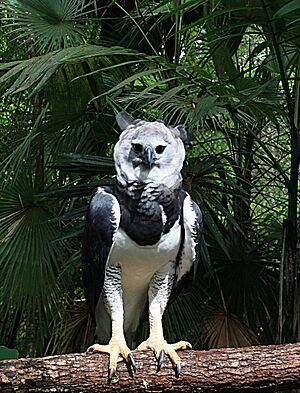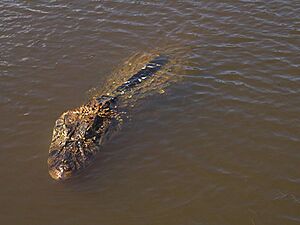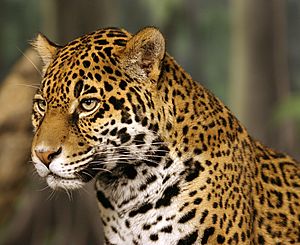Rupununi facts for kids
The Rupununi is a special area in the southwest of Guyana. It's right next to the amazing Brazilian Amazon. A big river called the Rupununi river flows through this region. Local people also call it Raponani. The name Rupununi comes from the word rapon in the Makushi language. It means the black-bellied whistling duck, a bird often seen along the river.
Contents
Geography of the Rupununi
The Rupununi River is a major branch of the Essequibo River. It starts in the Kanuku Mountains in southern Guyana. The river flows close to the border between Guyana and Brazil. Eventually, it joins the Essequibo River.
During the rainy season, the Rupununi River connects to the Amazon. This happens through a flooded creek called Pirara Creek. This creek links the Rupununi to the Takutu River. The area around the Rupununi River has lots of open grasslands (savannah), wet areas (wetlands), forests, and small mountains. This region, called Region 9, is huge! It covers about 57,750 square kilometers. More than 80 communities live here. Most people live in the Rupununi Savannah. The jungle areas are mostly empty, except near the big rivers.
Geology of the Rupununi
The land in the Rupununi is made of four main types of rock. In the very south, you find old rocks from a time called the Rhyacian period. These include changed sediments and volcanic rocks. The Kanuku Mountains are made of very old, high-grade rocks called gneisses. These rocks form a long belt.
There's also a special valley called the Takutu Graben. This valley was first filled with volcanic lava. Later, it got filled with sediments, including the Takutu Formation. To the north of this valley, you find flat layers of sandstone and other rocks. These rocks are from the Roraima Group. Scientists have found tiny, very old crystals called zircons here. They suggest even older rocks are hidden deep underground.
Animal Life in the Rupununi
The Rupununi River and its surroundings are full of amazing animals. It has many land and water environments. Many species that have disappeared from other parts of South America still live here. The freshwater areas of the Rupununi have an incredible number of different species. It's almost as rich in life as the Amazon! Animals and plants do very well here. This is because the Rupununi is quite isolated from human activities.
A group called the South Rupununi Biodiversity Assessment Team (BAT) explored the area. They said the Rupununi River is "very diverse." The northern Rupununi alone has over 1,400 types of animals with backbones. It also has more than 2,800 kinds of plants. And there are countless species of insects and other small creatures!
Birds of the Rupununi
The trees and plants along the Rupununi River are a safe home for many rare birds. A study by the BAT team found 306 different bird species along the river. The Red siskin (Carduelis cucullata) is a bird that was thought to be almost gone. But it was found again in the Rupununi River!
Another bird survey in the North Rupununi found even more birds. It counted 4,243 individual birds, from 292 species. Rare birds like the Crested doradito (Pseudocolopteryx sclateri) and the Sun parakeet (Aratinga solstitialis) were also seen. The famous Harpy eagle also lives here. It is the biggest bird of prey in South America.
Some notable birds include:
- Harpy eagle (Harpia harpyja)
- Red siskin (Carduelis cucullata)
- Rufescent tiger heron (Tigrisoma lineatum)
- Wattled jacana (Jacana jacana)
Reptiles of the Rupununi
Reptiles love the Rupununi River. They eat small fish and crabs. Another study by the BAT team found 34 different types of reptiles living along the river. The Black caiman is the biggest predator here. It can grow up to 5 meters long! Sadly, it became endangered. People hunted them a lot from the 1930s to the 1970s for their skin.
Some notable reptiles include:
- Black caiman (Melanosuchus niger)
- Emerald tree boa (Corallus caninus)
- Green anaconda (Eunectes murinus)
- Red-footed tortoise (Chelonoidis carbonaria)
- Neotropical rattlesnake (Crotalus durissus)
- Giant River Turtle (Podocnemis expansa)
Large Mammals of the Rupununi
The Rupununi is home to many large mammals of South America. This includes the biggest wild cats: the jaguar (Panthera onca) and the puma (Puma concolor). Both jaguars and pumas are very good at hiding. They can hunt many different animals, from turtles to dogs. However, they are sometimes hunted by people. This happens because they are seen as a threat to farm animals. This has caused their numbers to go down.
Another large mammal here is the Giant otter (Pteronura brasiliensis). It is the biggest otter in the world! Many types of monkeys also live here. Smaller plant-eating animals and insect-eaters, like the Tapir (Tapirus), also live and find food along the Rupununi River.
Some notable large mammals include:
- Jaguar (Panthera onca)
- Puma (Puma concolor)
- Giant Otter (Pteronura brasiliensis)
- Howler monkeys (Alouatta)
- Capybara (Hydrochoerus hydrochaeris)
- Giant Anteater (Myrmecophaga tridactyla)
Aquatic Life in the Rupununi
The Rupununi has one of the most diverse water environments on Earth. A total of 410 fish species live in the Rupununi. This is more than in French Guiana (298 species) or Suriname (309 species). Scientists believe there could be at least 600 different fish species here. This is because not many researchers study the fish in this area.
Giant fish also live in the Rupununi waters. The arapaima (Arapaima) and the Lau-Lau (B. filamentosum) can grow very big. They can be about 2 meters long, and sometimes even 4 meters! These huge fish have been found in the most hidden parts of the Rupununi River. But they are rarely seen or caught. Too much fishing has made these two species move deeper into unexplored areas of the Rupununi.
Some notable aquatic species include:
- Arapaima (Arapaima)
- Lau-Lau (B. filamentosum)
- Red-bellied piranha (Pygocentrus nattereri)
- Lukanani, Butterfly Peacock Bass (Cichla ocellaris)
- Redtail catfish (Phractocephalus hemioliopterus)
History of the Rupununi
Ancient Civilizations
Indigenous peoples have lived in the Rupununi for thousands of years. Scientists have found ancient rock carvings, called petroglyphs, along the Rupununi River. These carvings are thousands of years old. Before Europeans came, the Makushi, Wai-Wai, and Wapishana peoples lived here.
The Makushi people moved from what is now Brazil and Venezuela. They came to the northern Rupununi over 400 years ago. The Makushi people still live in the Rio Branco savannahs and northern Rupununi. They get their food from the many fish, animals, and forest resources in the area.
Age of Exploration
Sir Walter Raleigh believed that the famous golden city, El Dorado, was in the Rupununi. However, he never explored the river himself. Other early explorers, like Charles Waterton and Robert Hermann Schomburgk, tried to find El Dorado. They did visit the area where the myth was supposed to be, which is part of the northern Rupununi. But they never found the golden city.
Modern Development
Guyana is a developing country. It is working to improve its economy and environment. Using the Rupununi's resources, like farming, mining, and oil, could help Guyana grow. Roads are being improved, like the one connecting the Rupununi to Roraima in Brazil. This road will go all the way to Georgetown. A bridge has also been built at the Guyana-Brazil border. It links Lethem (Guyana) to Bonfim (Brazil).
These new roads and bridges will make it easier to move goods. But they also pose a risk to the Rupununi's delicate environment. To protect the Rupununi's ecosystem, groups that help the environment (NGOs) and the Guyanese government are working together. They want to create laws to stop harmful human activities that could hurt the environment and wildlife in the Rupununi.
Eco-tourism and Adventure Tourism
Eco-tourism is very important for Guyana's economy. It especially helps the local Amerindian people. Many ranches and lodges, like the Karanambu Ranch, welcome tourists. Karanambu Ranch is a protected area for giant otters and other endangered animals. It was started by Tiny McTurk in 1927. These places earn money from tourists visiting the Rupununi.
Near Karanambu is Caiman House. This is an ecolodge that helps fund a public library. The library has greatly improved school pass rates for local children. Conservation International has a website about the Rupununi. It shares details about eco-tourism places to stay. Some tourists travel by land from Georgetown to Lethem through the Rupununi savannah. Then they go on to Brazil. But travel can be very slow in the rainy season. The dirt roads get bad, and sometimes it's impossible to travel. Rock View Lodge and The Pakaraima Mountain Inn are near Annai. This is about 3-5 hours from Lethem. The Rupununi / Lethem Rodeo is a fun event for tourists during Easter. It happens in the dry season.
See also
- Rappu Falls
- Essequibo River
- List of rivers of Guyana
- Rupununi Savannah
- Amazon







